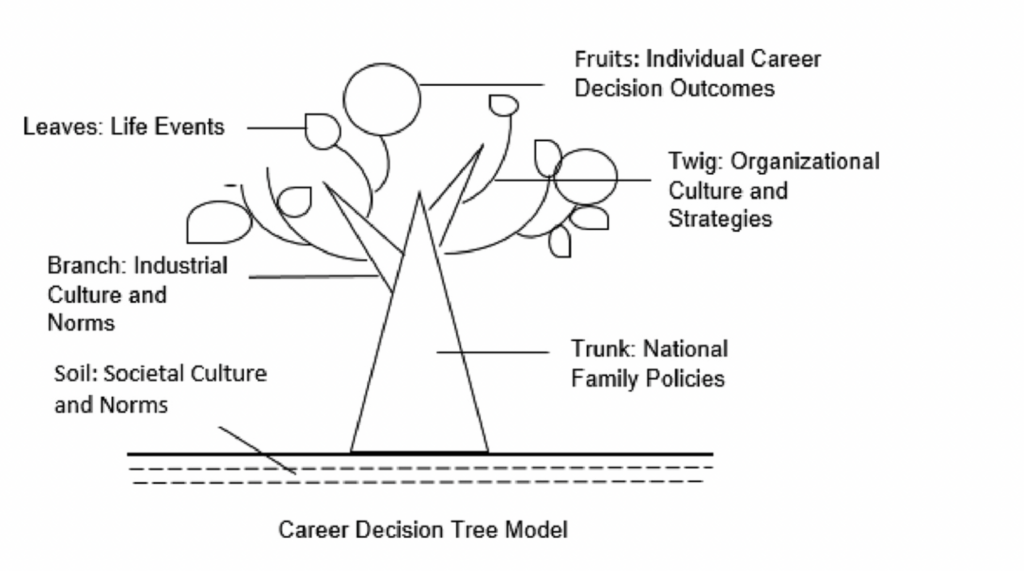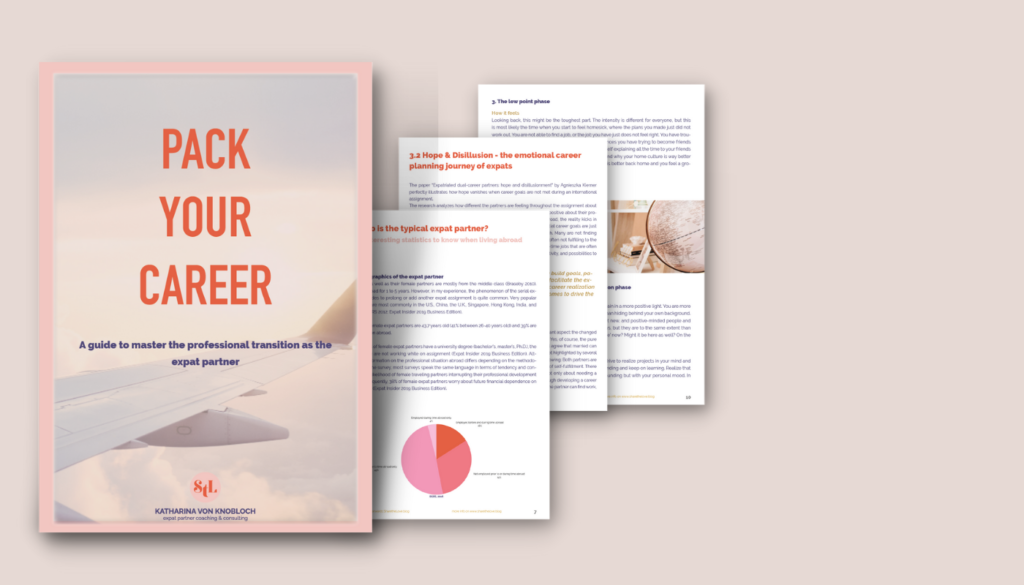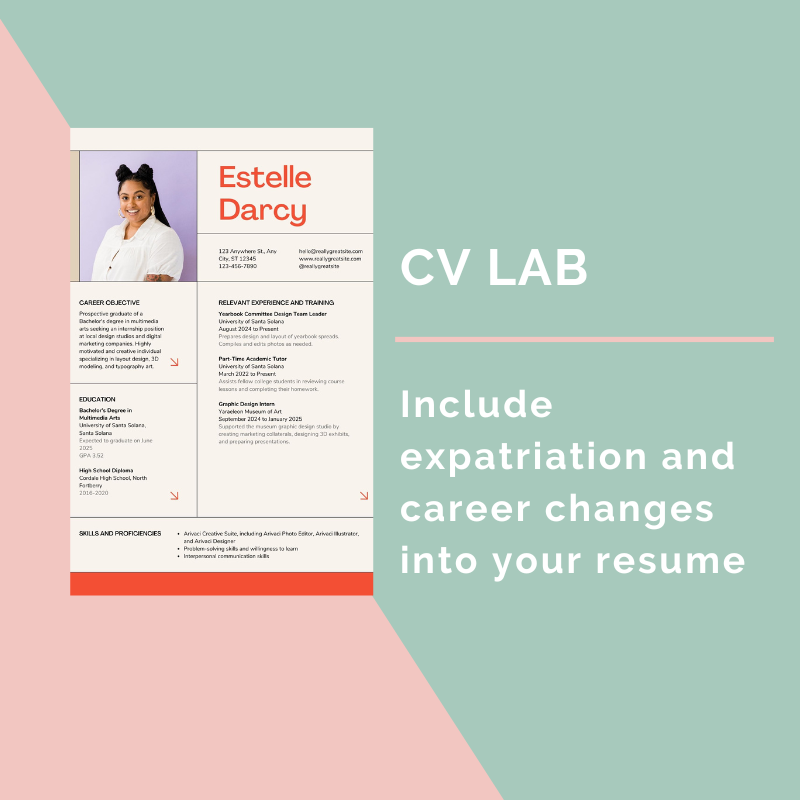
The Career Decision Tree Model
In this blog post, I present you with a new career concept about decisive and influencing factors on female careers around the globe. This model called, the career decision tree model, is also a great starting point to reflect on your own career decisions and I will show you how to work with it in this blog post.
The complexity of analysing WHY women are leaving the workplace and the role of society
In 2019, the researchers Bian and Wang put together an extensive literature review of 64 articles that focused on women’s career interruptions. Several of these papers showed that women, when compared with men, are taking a frayed and nonlinear career path in which career interruptions are expected to happen at certain points of their life. I have written about this phenomenon in both of my own studies which you can download here and here.
The decision of not working for a while has potential negative consequences such as disconnection from professional associations, threatened self-identity and human capital depreciation (such as significant lower wages when re-entering the workforce).However, most career women, especially working mothers, still choose to pause their career at certain points because of a shift of career focus or family reasons. When career women decide to reenter the workplace, it begins a re-socialization process in which they will experience the world of work in a new way.
The researchers Bian and Wang wanted to consolidate all the papers written in that area and look for patterns. Why do women leave the workplace? What are the influencing career decision factors that the individual but also we as a society should be aware of?
While reading through these papers they stumbled upon a number of career concepts and I will share more about these concepts in future posts. For now, I will focus on the so-called „Career Decision Tree Model“ the two researchers in this paper concluded with. It is a great visual, easy to understand but at the same time powerful enough to include all the complexity of this topic into a single concept.
Research shows that women, when compared with men, are taking a frayed and nonlinear career path in which career interruptions are expected to happen at certain points of their life
The Career Decision Tree Model (CDTM)
The graphic below portrays the essence of the concept by Bian and Wang after reading through the papers of the last decades. It shows a tree in which each element portrays another influencing element on female career decisions and career planning.

Let’s go through the meaning of each element as stated by Bian and Wang (2019).
The influencing factors on female career decision making
Soil - Societal norms culture and norms
Societal culture and norms in which gender expectations, gender stereotypes and social comparisons are embedded are the soil that supports the growth of the career decision tree. Existing literature reveals more traditional gender expectations toward men and women in eastern countries than in the west, which leads to more gendered organizations in the eastern labor market. Nutrition and hazards coexist in the soil, just as egalitarianism and gender stereotype endorsement can both be found in human society.
Trunk - National Family Policies
National family policies are the tree trunk that supports the crown and adds strength to the tree. National policies can shape the labor market structure and segmentation, which will directly influence women’s employment opportunities.
Branch - Industrial Culture and Norms
Each branch of the tree represents a specific industry or occupation, and each has a unique culture, norms, and expectations. For example, in the literature, much attention was given to SET industries in which women feel marginalized because of the mainstream working norms and the male-dominated culture. The image of an ideal worker in SET means working for extended hours, which is challenging for women caught in between family and work. Similarly, the nursing industry has witnessed a huge loss of talented female nurses because fixed and long working hours force them to choose positions such as bank nurses rather than hospital nurses. Given the differences in skill requirements and work intensity, industries vary greatly in terms of the work environment, thus affecting the career decisions of individuals in a specific industry.
Twig - Organizational Culture and Strategies
The twigs extended from branches represent organizations in different industries or occupations. While the culture of an organization is largely influenced by industry values and norms, each organization also has its own culture shaped by its leaders and their vision. As a result, although originated from the same branch, twigs can point in completely different directions. This reflects a dynamic relationship between organizations and industries. On one hand, organizations may find it difficult to transcend industry norms and commonly accepted practices; on the other hand, organizations manage to create their unique culture and strategies that influence women’s reentry decisions.
Leaves - Life Events
The leaves of the career tree are the life events of individuals in both the personal and professional domains. Examples of life events include receiving training and education, giving birth to a child, battling an illness, moving to a different country because of a spouse’s relocation, and assuming more domestic responsibilities. These life events and associated roles are integral parts of an individual’s career decision-making process.
Fruits - Individual Career Decision Outcomes
Working with the Career Decision Tree Model
So, what do you think about this career concept? In my opinion, it captures really well the complexity of influencing factors. It is not only about the family culture, the industry you are working in nor the profession, or the company itself. It is more a dynamic interplay of all different factors that influences career progression and that can lead to dropping out and dropping back in.
I especially like, that this concept does not only show the influencing factors but also the result of it calling it the fruit. The individual outcome of the mix of decision-making factors in all its glory and all its bitterness. A woman who decides to drop out does not only have to deal with the penalty part but also with an improved work-life balance of the chance to support her partner (or the other way round).
Like a tree, these different factors are influencing each other leading to different growth spurts and to the result that every tree looks different. There is no other tree on earth that looks exactly the same and it is very much fitting to the idea that also every woman and every career is unique. Hence, there are social norms to lead to if you want it or not but there is also that important decisive factor of your own personalty!
Reflection questions that can help to gain new insights into your own career decision tree
So how does your tree look like? What color does it have? What soil is your tree standing on? What flowes does it show? I invite you to got from soil, to trunk, to branch, to twig, leaves and flowers and ask yourself what the influencing factors in your scenario look like.
What are ideas and influencing factors that rather are more external and which factores are more based internally (e.g your personality and your values)?
What kind of soil and trunk do you wish to be for your own children and what does this tree look like for your partner?
In what part of this tree do you feel like the victim and where do you feel you made yourself a victim?
Close your eyes and go through each area of the tree or take a pen and paper and put your thoughts in writing depending on what you prefer. Really confronting yourself with the reality of each part of the tree can help you to analyze your very own decision-making process in career planning and put you back in the driver’s seat to take the next step with more power and strengths.

Further resources that will support you
There are a couple of resources I like to share with you that are also helping with career planning and reflections on your own career decision tree:
The thriving female expat study
In this study, I have interviewed 30 female breadwinners who took their careers abroad but due to very different reasons. Learn from their stories and their decision-making process. You can download the full report for free following this link.
The study about re-entering the workforce after a longer break
In my brand new study, I have followed the journey of several women re-entering the workplace after a longer break. They are sharing their feelings along the way, including the ups and downs and describing how they managed impostor syndrome and insecurities in the beginning. You can download the full study for free here.
The academic paper I was talking about in this blog post
In case you want to know more details on the academic paper I am referring to in this blog post you can follow this link and download the full report. It also gives a great overview of the literature in that field in general.
A glimpse into my 1:1 coaching program
If you are thinking about partnering with a career expert I am happy to take a look at your own situation and see whether coaching might be a great fit in this moment of your life. I invite you to book a free discovery call on my calendar and I am happy to walk you through the process. No strings attached!
I hope you found this concept as inspiring as I did and I can’t wait to hear from you and your thoughts! Feel free to jump into the comments or send me a direct email to info@sharethelove.blog.

Do you know anyone who might find this helpful? Share the Love by sharing this article
Ebook for the accompanying partner
Quitting your job and joining your partner abroad does not need to end your professional career. Learn what options you have and how to define what you really want during your time abroad. Make it to your own personal journey and get the most out of it!
MORE BLOG POSTS
Schreibe einen Kommentar Antworten abbrechen
We use cookies to optimize the website and our services. More Info on Cookies used
The cookie settings on this website are set to "allow cookies" to give you the best browsing experience possible. If you continue to use this website without changing your cookie settings or you click "Accept" below then you are consenting to this.










